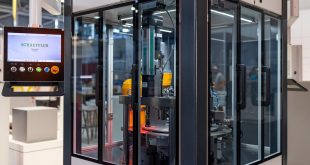Reliability is essential in automated production, and nowhere more than in the hard-pressed healthcare supply sector. At the time of the global COVID-19 crisis, OEM equipment builders rushed to increase capacity for producing personal protective equipment (PPE). Manufacturers of N95 face masks, a high-volume item of PPE, faced unprecedented demand worldwide.
While a single N95 mask is a relatively low-cost item, fast-moving production lines mean that any interruption to continuous operation is disproportionately expensive. Machine malfunctions not only cause lost production time but also result in costly manual intervention, and must be prevented.
Purpose-built machines for manufacturing N95 masks must dovetail several material feeds prior to assembly; they must also ensure that part-completed masks are positioned correctly during the process. Successive workstations incorporate multiple position-sensing and presence-detection sensors that monitor the status of material feeds and cutter position, as well as checking part alignment for welding and printing. It is highly desirable to source these devices from a single manufacturer, minimizing spares inventory and ensuring a common interface throughout an entire machine.
OEM designers specified rugged inductive sensors from the Contrinex Basic and Miniature ranges. Not only did the available selection match the functional requirement exactly, the immediate availability of all the required devices from stock eliminated delays in ramping up capacity. All the specified sensors feature IO-Link connectivity, providing a single, industry-standard interface to the machine control system.
Contrinex inductive sensors are designed with the needs of OEMs and system integrators in mind and provide an unobtrusive fit-and-forget solution. With a sensing distance of 4 mm, the two metal-cased M12 sensors used to monitor the positions of the steel fabric cutter and the printing head are robust and reliable. The M8 device that detects the feed position of the aluminium fixing strip has a V2A stainless-steel housing and an extended sensing distance of 2 mm, fitting snugly in the limited space available.
The extra-distance miniature M5 sensor fitted at the welding station has a nickel-silver housing and was selected because of its 2.5-mm sensing distance, eliminating any danger of accidental collision during operation. Connection to all the specified sensors is via a PVC-sheathed cable with a 3-pin connector or 2-metre flying lead; alternative lengths are available.
These highly versatile sensors meet designers’ needs for trouble-free operation using sensors from a single manufacturer. The solution is highly reliable, cost-effective and, critically, available without delay, allowing the immediate increase in machine-building capacity required by the OEM customer.
The no-cost option of the industry-standard IO-Link protocol ensures that best-in-class performance is coupled with ultimate ease of use in even the most demanding circumstances.
Contrinex sensors and more information are available from PLUS Automation.
 Instrumentation Monthly Test | Measurement | Control
Instrumentation Monthly Test | Measurement | Control


